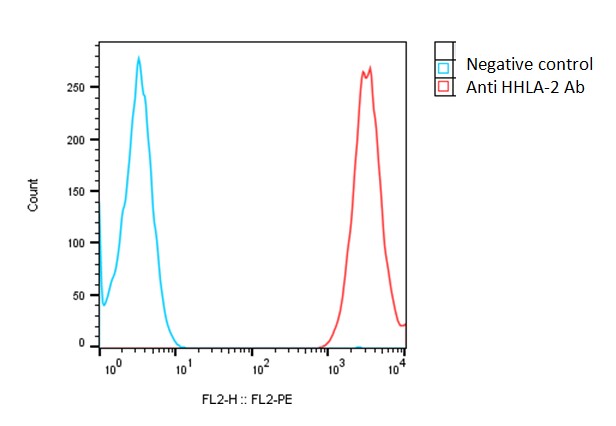
| Catalog Number | Product | Size | Price | |
|---|---|---|---|---|
| C3047 | Human HHLA-2-CHO-K1 Stable Cell Line | 2 vials | $3950 | Order |
| Catalog Number | C3047 |
|---|---|
| Cell Line Name | Human HHLA-2-CHO-K1 stable cell line |
| Accession Number | NM_001282556.2 |
| Host Cell | Adherent CHO-K1 |
| Quantity | Two vials of frozen cells (2x106 per vial) |
| Culture Medium | DMEM with 10% FBS, 4 µg/ml puromycin |
| Freezing Medium | 90% FBS and 10% DMSO |
| Storage | Liquid nitrogen upon receipt |
| Product Datasheet: | Download PDF |
Detection of human HHLA-2 expression on human HHLA-2-CHO-K1 stable cells using a monoclonal antibody specific for human HHLA-2 (Accurus, Cat. #A1021), followed by staining with PE-anti human antibody.

HERV-H LTR-Associating Protein 2 (HHLA-2), also known as B7y, B7H7, and B7-H5, is a transmembrane protein of the B7 family of immune checkpoint molecules that helps to modulate T cell activity and regulate the immune response in various physiological and pathological conditions. It binds to the receptor TMIGD2 (Transmembrane and Immunoglobulin Domain Containing 2), and can lead to both co-stimulatory and inhibitory signals, depending on the context and cellular environment. HHLA-2 is found to be expressed in various normal tissues, including the placenta, kidney, intestine, gall bladder and breast and on the surface of monocytes and B cells. Its expression pattern suggests potential roles in tissue homeostasis and immune regulation. HHLA-2 has been found to be overexpressed in several cancers. This upregulation is associated with tumor progression and immune evasion mechanisms employed by cancer cells. HHLA-2 overexpression has been linked to the inhibition of antitumor immune responses by suppressing T cell activation and promoting immune tolerance within the tumor microenvironment. The identification of HHLA-2 as a potential therapeutic target has led to investigations into developing HHLA-2-targeted immunotherapies. Strategies such as the blockade or agonistic stimulation of HHLA-2/TMIGD2 interactions are being explored to enhance anti-tumor immune responses, highlighting the potential of HHLA-2 as a target for cancer immunotherapy.
Janakiram M, et al. HHLA2 and TMIGD2: new immunotherapeutic targets of the B7 and CD28 families. Oncoimmunology.;8:e1629379. 2019.
Li Y, et al. KIR3DL3-HHLA2 and TMIGD2-HHLA2 pathways: The dual role of HHLA2 in immune responses and its potential therapeutic approach for cancer immunotherapy. J Adv Res. 47:137-150. 2023